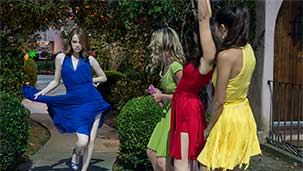Easiest buck you’ve ever made, right?
I mean—really, what part of La La Land seemed risky enough that they had to hire someone like you? It’s a vibrant, upbeat, wholly original musical starring Ryan Gosling and Emma Stone, and it was made by one of Hollywood’s hottest new talents, Whiplash writer and director Damien Chazelle. There’s no such thing as a sure bet in Hollywood, but outside of a Star Wars movie or comic book adaptations, La La Land is about as close to a sure bet as you can get.
Then again, maybe I’m reading the cards a bit late; the film has already won the People’s Choice Award at the Toronto International Film Festival and has enjoyed awards buzz since the first clips were released months and months ago. But it’s almost impossible to track the profit potential of an original non-Broadway musical. With the exception of a few low-budget indies (like Once or _Idlewild), most contemporary films classified as a musicals are either musician biopics, animated films, or music-themed films (like Pitch Perfect). But a true old-school musical – where the singing takes place off-stage and within imagined spaces – is a rare beast. Aside from Muppet movies, you’d have a hard time naming one in the past decade. Even Moulin Rouge! from 15 years ago was more a jukebox remix than a true original musical. So let me take it back: your salary might have been the best money the producers of La La Land spent, because you apparently convinced them to just shut up and sing.
It pays off immediately. La La Land wins the award for the fastest I’ve gotten the chills while watching a movie (taking the title away from Up!), which has as much to do with the aforementioned dearth of musicals and my excitement at seeing the scale of the traffic jam overture “Another Day of Sun” than it has to do with any emotion being conveyed by the characters (Gosling and Stone aren’t even part of the song).
The next big gamble that Chizelle took was his insistence on long takes and wide shots to cover the action. The former is de rigeur in cinema, with every cinematographer trying to out–Lubezki Emmanuel Lubezki, and while director of photography Linus Sandgren is a long way from challenging him for the crown (he often loses focus mid-shot and frequently frames clumsy transitions, which I think he can blame on the time he spent trying to meet the frenetic photographic demands of David O. Russell) he compensates for this lack of smoothness with old-school charm and inspired lighting designs. Most importantly, the insistence on shooting wide allows the choreography to play out in real-time and lets the audience lose themselves in the moment rather than try to follow the action. Gosling and Stone soft step their way through a basic (but endearing) toe-tapping routine that will be emulated on high school stages for years.
Those two leads, of course, are the real money in the bank. Even when the story seems to lose steam (and music) in the third act, enough groundwork has been laid by Gosling and Stone that we can’t help but be invested in the results. And, like all good gambles, it pays off—even if it’s not in the way you expect.
Sincerely,

Christopher







